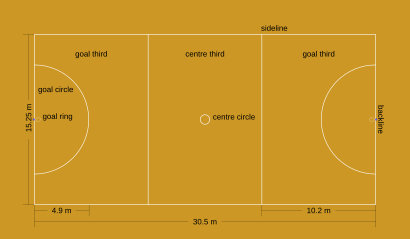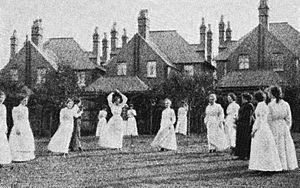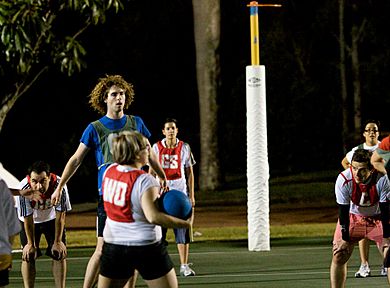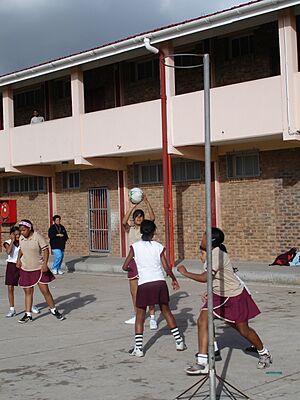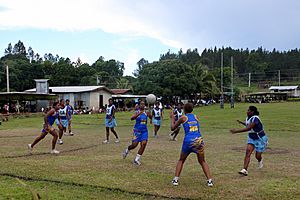Netball facts for kids
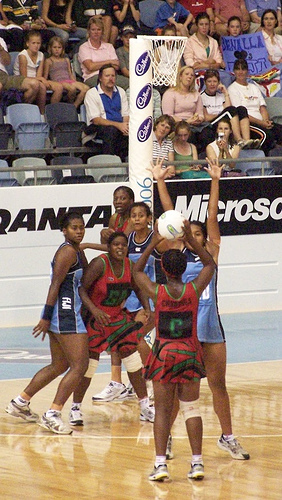
Malawi (red) playing Fiji (blue)
at the 2006 Commonwealth Games |
|
| Highest governing body | World Netball |
|---|---|
| First played | 1897, England, United Kingdom |
| Registered players | 561,000+ |
| Characteristics | |
| Contact | Limited |
| Team members | Seven on-court players per team - All-female teams - All-male teams - Mixed teams |
| Type | - team sport - ball sport |
| Equipment | Netball, bib |
| Venue | Netball court |
| Presence | |
| Olympic | IOC-recognised federation, 1995 |
| World Games | 1985–1993 |
Netball is a fast-paced ball sport played by two teams of seven players on a rectangular court. The main goal is to throw a ball through the opponent's goal ring. At the same time, your team tries to stop the other team from scoring. Netball is one of the few sports that was first created just for female players. It's played both indoors and outdoors, and it's very popular in schools, especially in Commonwealth countries.
Many people think netball was invented to stop women from playing basketball. But actually, netball started because an American sports teacher, Clara Gregory Baer, misunderstood the basketball rule book in 1895. Her changes became popular and were later made official rules for women's basketball by 1899.
Around the same time, Martina Bergman-Österberg introduced basketball to her female students in England in 1893. This game, first called 'women's basketball', slowly changed. By 1897, it became a separate sport, combining Bergman-Österberg's ideas with Baer's rules. The first official rules for netball were published in 1901. By 1960, the rules for international games were the same everywhere. The International Federation of Netball and Women's Basketball, now called World Netball, was formed to manage the sport worldwide.
Netball is quite different from basketball. One big difference is that netball goals don't have backboards. Also, in netball, you can't dribble (bounce the ball) or run while holding the ball. There's also less physical contact allowed between players. Netball players have specific positions, and each position can only move in certain areas of the court. This means netball relies a lot on accurate passing and smart positioning.
More than 20 million people play netball in over 80 countries, according to World Netball. There are over 70 national teams that are part of World Netball. Big leagues include the Netball Superleague in Great Britain, Suncorp Super Netball in Australia, and the ANZ Premiership in New Zealand. Major international events are the World Netball Championships, the Commonwealth Games, and the yearly Quad Series and Fast5 Series. In 1995, netball was recognized by the International Olympic Committee, but it's not yet an Olympic sport.
How Netball is Played
Games are played on a rectangular court with raised goal rings at each end. Each team tries to score goals by passing the ball down the court. Then, they shoot it through their goal ring. Players have special positions, which decide their role and where they can move on the court.
If a player has the ball, they can only hold it for three seconds. They must either shoot for a goal or pass to another player. The team that scores the most goals wins the game. A normal netball game lasts 60 minutes. There are also different versions of the game to make it faster and more exciting.
Court and Equipment
The goal rings are 380 mm (about 15 inches) wide and are on top of 3.05 m (10 feet) high goal posts. These posts do not have backboards. A semi-circular "shooting circle" with a 4.9 m (16 feet) radius is at each end of the court. The goal posts are inside this circle. Each team defends one shooting circle and attacks the other.
The netball court is 30.5 m (100 feet) long and 15.25 m (50 feet) wide. It's divided into three equal sections lengthwise. The ball is usually made of leather or rubber. It measures 680 to 710 mm (about 27-28 inches) around and weighs 397 to 454 g (about 14-16 ounces). A regular game has four 15-minute quarters.
Player Positions and Movement
Each team has seven players on the court. Every player has a specific position, which limits where they can move. Players wear a "bib" with a letter or two to show their position.
- Only two positions can enter the attacking shooting circle to shoot for a goal.
- Similarly, only two positions can enter the defensive shooting circle to stop the other team from scoring.
- Other players can only move in two-thirds of the court.
- The Centre player is special because they can move anywhere on the court, except into the shooting circles.
Game Start and Rules
Play starts at the beginning of each quarter and after every goal. A player in the Centre position passes the ball from the middle of the court. These "centre passes" switch between teams, no matter who scored last. When the umpire blows the whistle, four players from each team can move into the centre third to get the pass. The centre pass must be caught or touched in the centre third.
The ball is then moved up and down the court by passing. It must be touched by a player in each section of the court. Players can only hold the ball for three seconds. They must release it before the foot they were standing on when they caught it touches the ground again.
Players can only touch each other if it doesn't stop an opponent or the game. When defending, players must be at least 90 cm (3 feet) away from the player with the ball. If a player makes illegal contact, they cannot play until the penalty is taken. If a player drops the ball or misses a shot, they can't touch it again first unless it bounces off the goal post.
History of Netball
Netball started because Clara Baer misunderstood the early rules of James Naismith's new sport, basketball. Basketball was invented in 1891 in the United States. It was first played indoors with nine players per team, using a football thrown into peach baskets. Basketball quickly spread, and different rules appeared.
Around the same time, in 1892, a physical education teacher named Senda Berenson made changed rules for women's basketball. Her rules led to what became women's basketball. But netball grew into a completely separate sport.
How Netball Began
Clara Baer was a sports teacher in New Orleans. She asked James Naismith for his basketball rules. The rules came with a diagram of the court that had lines. These lines were meant to show where players could best move. But Baer thought they meant players couldn't leave those areas. This mistake was the start of netball. Her version of the rules, which included these restricted zones, became official for women's basketball in 1899 and spread widely.
In 1893, Martina Bergman-Österberg introduced a version of basketball to her female students in London, England. The rules were changed over several years: the game moved outdoors, played on grass, and baskets were replaced with rings that had nets. By 1897 and 1899, rules from women's basketball in the United States were added. Österberg's new sport was named "net ball". The first official netball rules were published in 1901.
From England, netball spread to other countries in the British Empire. Different names and rules appeared. For example, "women's (outdoor) basketball" arrived in Australia around 1900 and in New Zealand from 1906. "Netball" was played in Jamaican schools by 1909.
Netball was seen as a good sport for women to play. Its rules, with restricted movement, fit with ideas about women in sports at the time. The sport became very popular in schools. Leagues and competitions started in the early 1900s. In 1924, New Zealand created the first national netball organization.
Early international games were hard to organize because of different rules and lack of money. The first international netball game was in Melbourne on August 20, 1938, between Australia and New Zealand. Australia won 40–11.
In 1957, efforts began to make netball rules the same worldwide. By 1960, international rules were standardized. The International Federation of Netball and Women's Basketball (later the International Netball Federation or INF) was formed to manage the sport globally.
Netball's Growth and Changes
Representatives from England, Australia, New Zealand, South Africa, and the West Indies met in Sri Lanka in 1960 to standardize the rules. The game spread to African countries in the 1970s. In the United States, netball also grew in the 1970s, especially in New York. The United States of America Netball Association was created in 1992. The game also became popular in Pacific Island nations like the Cook Islands, Fiji, and Samoa.
In Australia, "women's basketball" was used for both netball and basketball. In the 1950s and 1960s, there was a push to change the name to "netball" to avoid confusion. In 1970, the All Australia Netball Association officially changed the name to "netball" in Australia.
The first international tournament, now called the World Netball Championships, was held in 1963 in England. It has been held every four years since then. The World Youth Netball Championships started in 1988 for younger players. In 1995, the International Federation of Netball Associations was recognized by the International Olympic Committee. Three years later, netball was played at the 1998 Commonwealth Games for the first time.
Men's and Mixed Netball
Netball was created for girls and women, and it's still most popular with them. Women's netball at high levels often gets outside funding. However, male netball teams and mixed-sex teams usually have to fund themselves. Men's netball started growing in Australia in the 1980s, with the first men's championship in 1985. Other countries with men's national teams include Canada, Fiji, Jamaica, Kenya, Pakistan, and the United Arab Emirates.
In 2004, New Zealand and Fiji sent teams to compete in the Australian Mixed and Men's National Championships. By 2006, mixed netball in Australia had as many male players as rugby union.
Netball Game Variations
Netball has different versions to make it more exciting or suitable for different players.
Indoor Netball
Indoor netball is played inside, often with a net around the court. This net stops the ball from leaving the court, making the game faster because there are fewer stops.
There are different types of indoor netball:
- Seven-per-side: Called "action netball," it's similar to regular netball but with two 15-minute halves. It's played in Australia, New Zealand, South Africa, and England.
- Six-per-side: Played in New Zealand. Two Centre players can move almost anywhere. Other players are limited to one half of the court. Attacking players can shoot for two points from outside the shooting circle.
- Five-per-side: Players can move around most of the court, but shooting circles are still restricted to certain players.
Fast5
Fast5 (originally Fastnet) is a faster version of netball. It's designed to be more exciting for TV viewers and to attract more fans and sponsors.
- Games are much shorter: each quarter is only six minutes long, with a two-minute break.
- Coaches can give instructions from the sideline during play.
- Teams can make unlimited substitutions.
- Attacking players can shoot two-point goals from outside the shooting circle.
- Each team can choose one "power play" quarter. In this quarter, goals scored by that team are worth double points, and the team that was scored against takes the centre pass.
Netball for Children
Netball has been changed in several ways to suit children. The rules are similar to adult rules, but things like quarter length, goal height, and ball size are adjusted.
- Fun Net: Developed by Netball Australia for five- to seven-year-olds. It uses games and activities to teach basic netball skills. There are no winners or losers. Goal posts are 2.4 m (8 feet) high, and a smaller ball is used.
- Netta: Also from Netball Australia, for 8- to 11-year-olds. Goal height and ball size are the same as for adults. Players rotate positions during the game so everyone gets to play every role. Netta helps develop passing and catching skills. Players can hold the ball for six seconds, instead of three.
- High Five Netball: Promoted by the All England Netball Association for 9- to 11-year-old girls. It has only five positions, and players swap roles during the game. When a player is not on the court, they help by keeping time or score. High Five Netball has four six-minute quarters.
Netball Governance
The main international organization for netball is World Netball, based in Manchester, England. It was founded in 1960. World Netball is in charge of:
- Creating world rankings for national teams.
- Keeping the rules for netball up to date.
- Organizing major international competitions.
As of July 2019, World Netball has 53 full and 19 associate national members in five regions. Each region has its own netball federation.
| World Netball region | Regional federation |
|---|---|
| Africa | Confederation of African Netball Associations |
| Americas | Americas Federation of Netball Associations |
| Asia | Netball Asia |
| Europe | Netball Europe |
| Oceania | Oceania Netball Federation |
World Netball works with other big sports organizations like the General Association of International Sports Federations and the International World Games Association. It also follows the World Anti-Doping Code to keep sports fair.
Netball in Canada
Netball came to Canada in the early 1960s. The first organized games in Canada were in Montréal, Quebec in 1962. The Ontario Amateur Netball Association, now "Netball Ontario" (NBO), started in 1974. The first national Canadian netball championship was held in 1975. Today, netball is mainly played in Québec, Ontario, Alberta, and British Columbia.
In 1996, Canada hosted the third World Youth Netball Championships. The Canada national netball team was also formed.
International Netball Competitions
Netball is very popular in Commonwealth countries. More than 20 million people play netball in over 80 countries. International tournaments are held in each of the five World Netball regions, either every year or every four years. School leagues and national club competitions have been around since the early 1900s in places like England, Australia, New Zealand, and Jamaica.
Netball was first included in the 1998 Commonwealth Games and has been a "core" sport ever since. This means it must be played at every Commonwealth Games.
Regional Competitions
- The Confederation of African Netball Associations organizes a big African tournament. Teams from countries like Botswana, Malawi, and South Africa compete. This tournament often helps teams qualify for the World Championships.
- The Americas Federation of Netball Associations (AFNA) hosts two tournaments each year: the Caribbean Netball Association (CNA) Under 16 Championship and the AFNA Senior Championship. These tournaments also help teams qualify for the World Championship.
- The Asian Netball Championship is held every four years. It includes teams from countries like Singapore, Malaysia, and Sri Lanka. There's also an Asian Youth Netball Championship for girls under 21.
- The main netball competition in Europe is the Netball Superleague, with teams from England, Wales, and Scotland. Matches are shown on Sky Sports.
- Netball has been part of the Pacific Games, a multi-sport event for 22 countries in the South Pacific.
Major Leagues
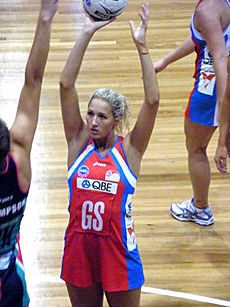
The ANZ Championship was a big competition between Australia and New Zealand teams from 2008 to 2016. It helped netball become a semi-professional sport in both countries, with more media coverage and higher player salaries. This competition was replaced in 2017 by new leagues: the Suncorp Super Netball in Australia and the ANZ Premiership in New Zealand.
Top Netball Championships
There are four main international netball competitions: the Netball World Cup, Netball at the Commonwealth Games, Netball Quad Series, and Fast5 Netball World Series. Netball is also played at other large regional sports events.
The most important netball competition is the World Netball Championships, held every four years. It started in 1963 in England. Australia and New Zealand have won most of the titles. Trinidad and Tobago is the only other team to win a championship, sharing the title with New Zealand and Australia in 1979.
The Fast5 Series is a competition for the top six national netball teams. It's organized to make the sport more popular. It's a short, three-day event with modified Fast5 rules, similar to Twenty20 cricket or rugby sevens.
Netball's international organization was recognized by the International Olympic Committee in 1995 after 20 years of trying. Even though it hasn't been played at the Summer Olympics, many people are working to get it included. Being an Olympic sport would help netball grow globally by getting more media attention and funding.
Netball Injuries
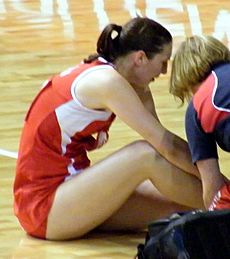
Studies show that about 5% of players get an injury over 14 weeks of playing. The most common injury is to the ankle, like a sprain or sometimes a fracture. Knee injuries, including ACL injuries, are less common. These injuries often happen because of incorrect landing. Not warming up properly can also increase the risk.
Players in higher-level games, both adults and juniors, are more likely to get injured. This is because the game is played at a faster and more intense pace at these levels.
See also
 In Spanish: Netball para niños
In Spanish: Netball para niños
- Netball para niños (Netball for children in Spanish)


